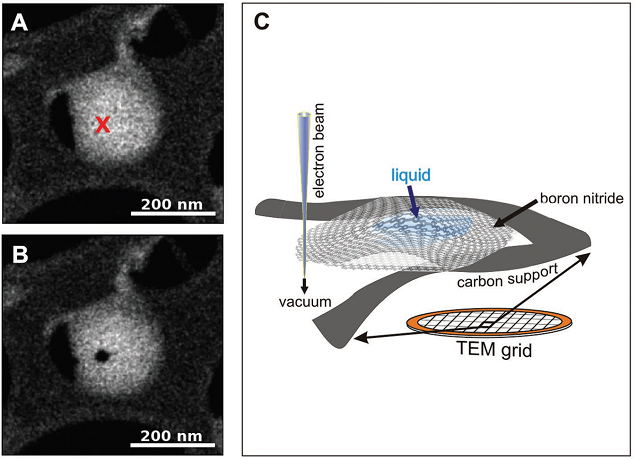Vibrational spectra of liquids with nanometer spatial resolution
The ability to examine the vibrational spectra of liquids with nanometer spatial resolution will greatly expand the potential to study liquids and liquid interfaces. After all, modern technology, including many manufacturing processes, and science depend on understanding the detailed interactions at such nanoscopic interfaces. Actually, a better comprehension of the fundamental properties of the commonest of liquids, water, including anomalies in its phase diagram, electrochemistry, and changes in bonding due to nanoscale confinement, is central to many research areas.
Now, an international team of researchers, including Andrea Konecna and Javier Aizpurua from CFM and DIPC, report 1 a novel way of characterizing the vibrational properties of liquid water with high spatial resolution using transmission electron microscopy. These results are an important milestone for liquid and isotope-labeled materials characterization, combining nanoscale imaging with vibrational spectroscopy in an electron microscope.

The researchers show that by encapsulating H2O between two-dimensional hexagonal boron nitride (h-BN) layers, it is now possible to quantify the structure of the liquid and its interaction with the hosting solid-state surfaces, as well as identify isotopes using electron energy-loss spectroscopy (EELS).
The electron microscope they use, equipped with a high-energy-resolution monochromator, is shown to record vibrational spectra of liquids and molecules with signals sensitive to surface and bulk morphological properties of the liquid both at the nano and micrometer scales. Vibrational EELS in a monochromated scanning transmission electron microscope (STEM) is a recently developed approach that allows the characterization of surface species including OH groups attached to nanoparticles, organic compounds such as the nucleobase guanine, and low-pressure ionic liquids adsorbed onto substrates commonly used in transmission electron microscopy.
The achievable energy resolution of the latest generation of monochromators has so far been 10–30 meV, but it has recently improved to 5 meV. Vibrational EELS in the STEM can be carried out in an “aloof” scattering geometry that provides nanometer-scale spatial resolution and minimizes radiation damage, thus avoiding a major obstacle for examining liquids in an electron microscope.
Other techniques, like tip-enhanced Raman spectroscopy and infrared scanning near-field optical microscopy, have previously been employed to study organic compounds at nanoscale resolution. These methods rely on the interaction between a sharp etched tip and the sample, with the resolution limited by the tip–sample contact. The overall resolution limit of these scanning-probe techniques can be between 10 and 25 nm, and must be performed with the tip immersed in a liquid, or in a liquid cell geometry. In a liquid cell, the spatial resolution will be limited by the surface of the encapsulating membrane.
Vibrational EELS within a STEM employs a different methodology and can be regarded as highly complementary to these surface probe techniques. The spatial resolution of EELS is limited by the delocalization of the low-angle scattered vibrational EELS signal and the potential for electron beam damage to the specimen. Resolutions of better than 1 nm have been reported in boron nitride when the high angle scattered part of the vibrational signal is considered. The spectral resolution of vibrational EELS is lower than that of tip-enhanced Raman spectroscopy or scanning near-field optical microscopy, but EELS is less sensitive toward surface states. Vibrational EELS, then, is capable of probing a volume as well as surfaces, and does not require the interface to be fixed to the support substrate, allowing investigation of the properties of liquids and liquid interfaces themselves.
This work provides the first example of vibrational spectroscopy of liquid water and isotope identification in a transmission electron microscope. The combination of these developments creates a unique opportunity for nanoscale vibrational spectroscopy of water and other vacuum or atmosphere incompatible liquids. As a result, the study of changes in the structure and orientation of water (and other liquids) next to solid surfaces, solidification fronts, suspended nanoparticles, or in reactive systems utilizing flow and isotope labeling now become possible.
Author: César Tomé López is a science writer and the editor of Mapping Ignorance.
References
- Jacob R. Jokisaari, Jordan A. Hachtel, Xuan Hu, Arijita Mukherjee, Canhui Wang, Andrea Konecna, Tracy C. Lovejoy, Niklas Dellby, Javier Aizpurua, Ondrej L. Krivanek, Juan-Carlos Idrobo, and Robert F. Klie (2018) Vibrational Spectroscopy of Water with High Spatial Resolution Advanced Materials doi: 10.1002/adma.201802702 ↩